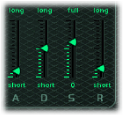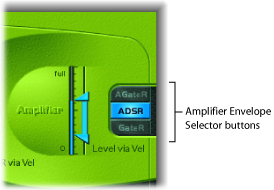Using the ES1 Envelope Parameters
The ES1 features an attack, decay, sustain, and release (ADSR) envelope that can shape the filter cutoff and the level of the sound over time.

Using the Envelope to Control ES1 Cutoff Frequency
The envelope generator modulates the filter cutoff frequency over the duration of a note. The intensity of this modulation—and how it responds to velocity information—is set by the ADSR via Vel slider arrows (in the Filter Parameters section).

The modulation range is determined by the two arrows. The minimum amount of modulation is indicated by the lower arrow. The upper arrow indicates the maximum amount of modulation. The blue bar between the arrows shows the dynamic range of this modulation. You can simultaneously adjust the modulation range and intensity by dragging the blue bar and moving both arrows at once.
Tip: If you’re unfamiliar with these parameters, set the Cutoff to a low value, Resonance to a high value, and move both of the ADSR via Vel arrows upwards. Constantly strike a note on the keyboard while changing the arrows to discover how these parameters work.
Using the Envelope to Control the ES1 Amplifier
The AGateR, ADSR, and GateR buttons (in the Amplifier Parameter section) define which of the ADSR envelope generator controls affect the amplifier envelope. All ADSR parameters remain active for the filter.

The letters A, D, S, and R refer to the attack, decay, sustain, and release phases of the envelope (see Using the ES1 Envelope Parameters). Gate refers to a control signal used in analog synthesizers that tells an envelope generator that a key is pressed. As long as an analog synthesizer’s key is pressed, the gate signal maintains a constant voltage. When Gate is used as a modulation source in the voltage-controlled amplifier (instead of the envelope itself), it creates an organ type envelope without any attack, decay, or release-an even, sustained sound.
In the ES1, the Amplifier Envelope selector buttons have the following effect on played notes:
- AGateR: The Attack and Release sliders of the ADSR Envelope control the attack and release phases of the sound. In-between these phases, the Gate control signal is used to maintain a constant level, while the note is held. As soon as you release the key, the release phase begins. The Decay and Sustain sliders of the ADSR Envelope have no impact on the sound’s level.
- ADSR: This is the standard operating mode of most synthesizers, where the level of the sound over time is completely controlled by the ADSR Envelope.
- GateR: The Gate control signal is used to maintain a constant level, while the note is held. As soon as you release the key, the release phase begins. The Attack, Decay and Sustain sliders of the ADSR Envelope have no impact on the sound’s level.